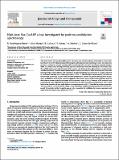Por favor, use este identificador para citar o enlazar a este item:
http://hdl.handle.net/10261/287753COMPARTIR / EXPORTAR:
 SHARE SHARE
 CORE
BASE CORE
BASE
|
|
| Visualizar otros formatos: MARC | Dublin Core | RDF | ORE | MODS | METS | DIDL | DATACITE | |

| Título: | High-heat flux Cu-0.8Y alloys investigated by positron annihilation spectroscopy |
Autor: | Domínguez-Reyes, R.; Monge, M.A.; Galiana, B.; Ortega, Y.; Muñoz, A. CSIC; Carro-Sevillano, G. | Palabras clave: | Copper alloys Oxide dispersion strengthened Positron annihilation High-heat flux materials Equal channel angular pressing Reinforced materials |
Fecha de publicación: | 2022 | Editor: | Elsevier BV | Citación: | Journal of Alloys and Compounds 900: 163430 (2022) | Resumen: | This work studies the thermal stability of the microstructure and the evolution of the defects of two high-heat flux Cu-0.8 wt%Y alloys fabricated following two alternative powder metallurgy routes. One batch was produced by direct hot isostatic pressing (HIP) consolidation of Cu-0.8 wt%Y pre-alloyed atomized powders while an additional ball milling processing step was introduced before HIP sintering for the second alloy. The stability and recovery characteristics of the vacancy type defects in these alloys in the as-produced state and after processing by severe equal channel angular pressing to achieve a refine microstructure have been investigated by positron lifetime and coincidence Doppler broadening measurements in samples subjected to isochronal annealing from room temperature to 900 °C. Microhardness measurements and electron transmission microscopy analysis have also been performed to support the results obtained from the positron annihilation spectroscopy analysis techniques. The recovery curves of the positron lifetime and S-W plots show a recovery stage in agreement with the recovery stage V for Cu. However, a full recovery is not accomplished, and a stage that reverts the previous recovery takes place after annealing above ~600 °C, that leads to the formation of very stable defects at temperatures up to 900 °C, identified as vacancy aggregates and nanocavities. The characteristic shape of the coincidence Doppler broadening indicates that the dispersed Y-O particles in the Cu matrix appear to be responsible for stabilizing the vacancy aggregates and nanocavities for temperatures above 600–700 °C. | Versión del editor: | https://doi.org/10.1016/j.jallcom.2021.163430 | URI: | http://hdl.handle.net/10261/287753 | DOI: | 10.1016/j.jallcom.2021.163430 | Identificadores: | doi: 10.1016/j.jallcom.2021.163430 issn: 0925-8388 |
| Aparece en las colecciones: | (CENIM) Artículos |
Ficheros en este ítem:
| Fichero | Descripción | Tamaño | Formato | |
|---|---|---|---|---|
| 1-s2.0-S0925838821048404-main.pdf | 8,32 MB | Adobe PDF |  Visualizar/Abrir |
CORE Recommender
SCOPUSTM
Citations
2
checked on 20-abr-2024
WEB OF SCIENCETM
Citations
1
checked on 27-feb-2024
Page view(s)
21
checked on 24-abr-2024
Download(s)
15
checked on 24-abr-2024
Google ScholarTM
Check
Altmetric
Altmetric
Este item está licenciado bajo una Licencia Creative Commons

